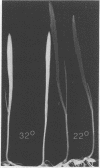Abstract
A specific high temperature-induced deficiency of chloroplast ribosome formation, as indicated by the absence of chloroplast rRNA, has been observed in the leaves of light- or dark-grown seedlings of Avena sativa L., Hordeum vulgare L., and Triticum aestivum L. at certain temperatures between 28 and 34 C. While the growth of the leaves (size, morphology, total amino nitrogen content) was little affected by the elevated temperature, chlorophyll accumulation was strongly inhibited, amounting to only 2 to 20% of its content in 22 C-grown leaves which were used as a reference for normal development. The carotenoid contents were also lower but still reached at least 15 to 20% of the corresponding measurements at 22 C. Ribulose-1,5-bisphosphate carboxylase was absent at the higher temperature while NADP-glyceralde-hydephosphate dehydrogenase reached high activities. For the peroxisomal marker enzyme hydroxypyruvate reductase, 30 to 70% of the activity present in 22 C-grown leaves was found in extracts from high temperature-grown leaves. Fumarase reached 1.5- to 4-fold higher activities at the elevated growth temperature than at 22 C. Leaves of Pisum sativum L. were completely chlorotic and deficient of 70S ribosomes at 33 C but simultaneously suffered from a severe general inhibition of their growth. In Zea mays L., a formation of chlorotic leaves was not observed at elevated temperatures.
Full text
PDF




Images in this article
Selected References
These references are in PubMed. This may not be the complete list of references from this article.
- Arnon D. I. COPPER ENZYMES IN ISOLATED CHLOROPLASTS. POLYPHENOLOXIDASE IN BETA VULGARIS. Plant Physiol. 1949 Jan;24(1):1–15. doi: 10.1104/pp.24.1.1. [DOI] [PMC free article] [PubMed] [Google Scholar]
- Bartels P. G., Matsuda K., Siegel A., Weier T. E. Chloroplastic ribosome formation: inhibition by 3-amino-1,2,4-triazole. Plant Physiol. 1967 May;42(5):736–741. doi: 10.1104/pp.42.5.736. [DOI] [PMC free article] [PubMed] [Google Scholar]
- Feierabend J., Berger C., Meyer A. Spezifische Störung von Entwicklung und Enzymbildung der Plastiden höherer Pflanzen durch hohe Wachstumstemperaturen. Z Naturforsch B. 1969 Dec;24(12):1641–1647. [PubMed] [Google Scholar]
- Loening U. E. The fractionation of high-molecular-weight ribonucleic acid by polyacrylamide-gel electrophoresis. Biochem J. 1967 Jan;102(1):251–257. doi: 10.1042/bj1020251. [DOI] [PMC free article] [PubMed] [Google Scholar]
- McWilliam J. R., Naylor A. W. Temperature and plant adaptation. I. Interaction of temperature and light in the synthesis of chlorophyll in corn. Plant Physiol. 1967 Dec;42(12):1711–1715. doi: 10.1104/pp.42.12.1711. [DOI] [PMC free article] [PubMed] [Google Scholar]
- Millerd A., Goodchild D. J., Spencer D. Studies on a Maize Mutant Sensitive to Low Temperature II. Chloroplast Structure, Development, and Physiology. Plant Physiol. 1969 Apr;44(4):567–583. doi: 10.1104/pp.44.4.567. [DOI] [PMC free article] [PubMed] [Google Scholar]
- Müller B., Ziegler I., Ziegler H. Lichtinduzierte, reversible Aktivtätssteigerung der NADP-abhängigen Glycerinaldehyd-3-phosphat-Dehydrogenase in Chloroplasten. Zum mechanismus der reaktion. Eur J Biochem. 1969 May 1;9(1):101–106. doi: 10.1111/j.1432-1033.1969.tb00581.x. [DOI] [PubMed] [Google Scholar]
- Parish J. H., Kirby K. S. Reagents which reduce interactions between ribosomal RNA and rapidly labelled RNA from rat liver. Biochim Biophys Acta. 1966 Dec 21;129(3):554–562. doi: 10.1016/0005-2787(66)90070-0. [DOI] [PubMed] [Google Scholar]
- RACKER E. Spectrophotometric measurements of the enzymatic formation of fumaric and cis-aconitic acids. Biochim Biophys Acta. 1950 Jan;4(1-3):211–214. doi: 10.1016/0006-3002(50)90026-6. [DOI] [PubMed] [Google Scholar]




